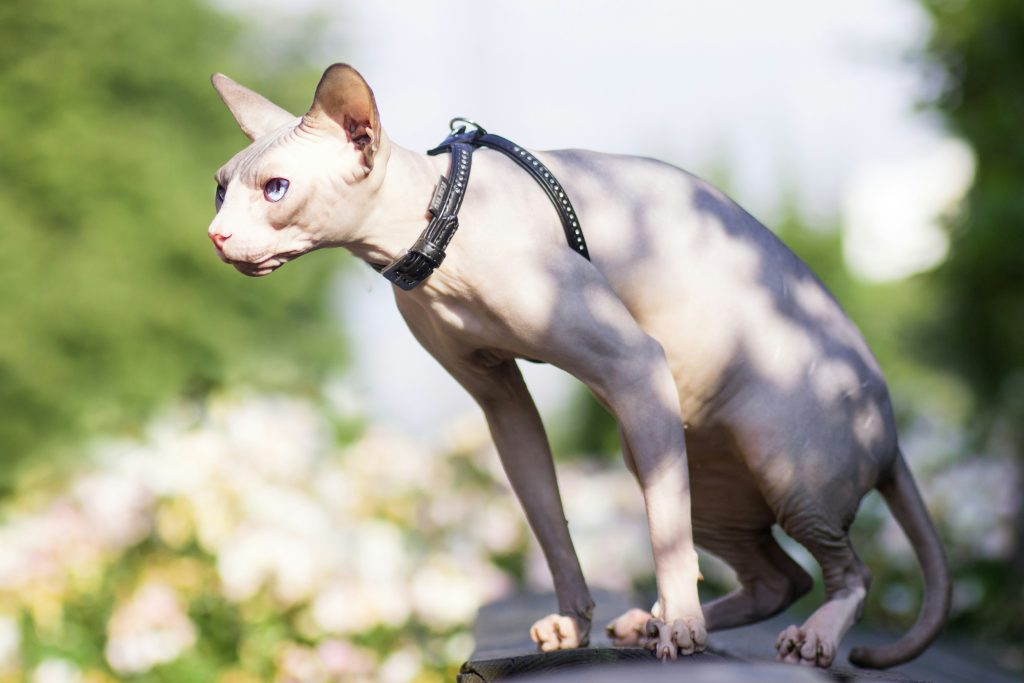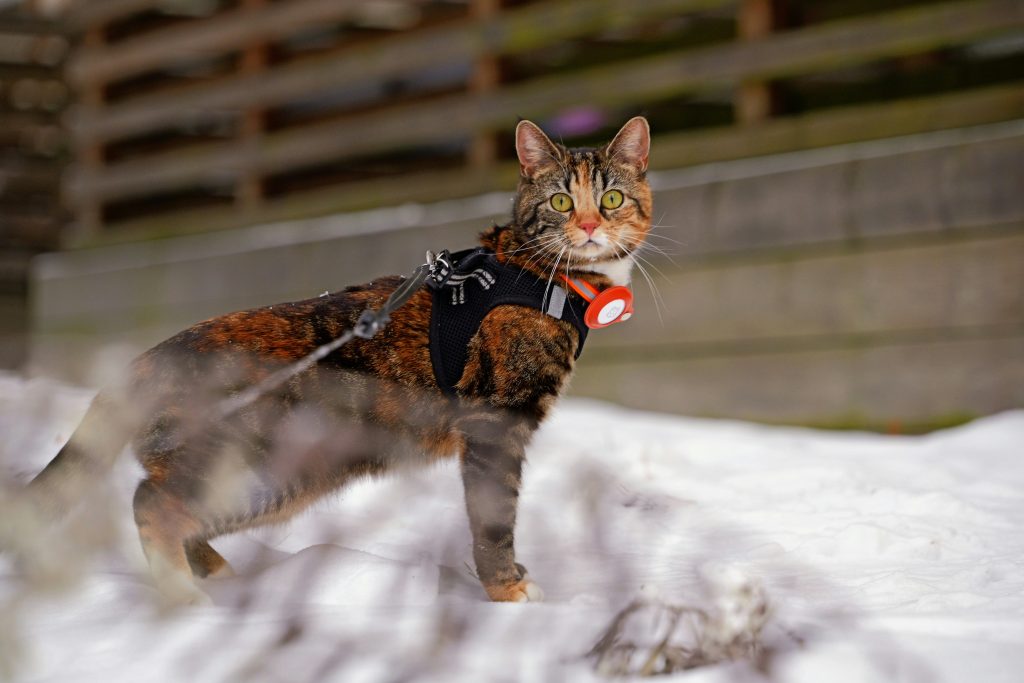Table of Contents
Embarking on outdoor walks with your feline companion can be an enriching experience for both you and your pet. However, ensuring your cat’s safety is paramount, which is where a cat harness comes into play. Whether you’re a seasoned cat parent or new to the concept, this guide will quickly walk you through putting a harness on your cat. From the snug fit of the harness to the gentle loop over the cat’s head, we’ll help you secure your cat’s trust and comfort.
Harness training your cat might seem daunting, but with patience and the right approach, you can reward your cat for their cooperation and transform them into a true adventurer. Continue reading to become a certified feline training expert in the art of the cat harness and help your cat explore the great outdoors safely.
Introduction to Cat Harness Usage
For the adventurer cat, a harness is a passport to exploring the world beyond the windowsill. It offers a safe way to satisfy their curiosity and allows them to experience new sights, sounds, and smells.
Using a harness instead of a collar provides better control and minimizes the risk of injury if your cat tries to bolt or climb. A harness distributes pressure more evenly around your cat’s body, reducing strain on their neck and back.
When it comes to harness training, patience is vital. Not all cats will take to a harness immediately, and that’s perfectly normal. Going at your cat’s pace is essential, and positive reinforcement is used to build their comfort and confidence slowly. With consistent and gentle training, even the most hesitant cat can learn to associate the harness with positive experiences.

Selecting the Perfect Cat Harness
Finding the perfect harness is the first step in preparing for outdoor adventures with your cat. You want a harness that fits well and is comfortable for your cat, ensuring they feel secure without restricting movement. It’s a balance of safety, comfort, and style—after all, your cat is a true adventurer and deserves to look the part.
Consider your cat’s size, breed, and temperament when choosing a harness. A harness that is too tight can be uncomfortable, while one that’s too loose can be a safety hazard. The correct harness will allow your cat to move freely and confidently as they explore the great outdoors with you.
Understanding Different Harness Types
There are several types of harnesses to suit the needs of every feline explorer. The H-style harness is a popular choice, offering simplicity and adjustability. Vest harnesses, on the other hand, provide more coverage and can be more comfortable and secure for some cats.
When selecting a harness and leash set, ensure it is the right size—significantly if your cat is still growing. The harness should allow for a snug fit that doesn’t chafe or pinch, making every adventure with your actual adventurer cat comfortable and secure.
Determining the Correct Harness Size
Finding a perfectly fitting harness is essential to ensuring your cat’s safe and enjoyable adventures. A well-fitting harness is snug enough to prevent escape but leaves room for comfort. Your true adventurer should be able to move freely without the harness sliding or twisting. Remember that a growing kitten will require regular size adjustments or a new harness as it matures.
Material Matters: What Your Cat Harness Should Be Made Of
The material of your cat’s harness is as important as the fit. Look for durable, lightweight fabrics that can withstand the rigors of outdoor exploration while keeping your cat comfortable. Breathability is essential for keeping your cat calm, and padded materials can prevent rubbing and discomfort during longer walks.
Step-By-Step Guide to Fitting a Cat Harness
Putting the harness on your cat starts with ensuring a good fit. The harness should be snug but not tight, allowing you to slide two fingers between it and your cat’s body. Vest harnesses may require different fitting techniques than those with two loops, so always refer to the manufacturer’s guidelines.
Preparing Your Cat for Harness Training
Before harnessing your cat, observe its body language to ensure it is relaxed. Start with short training sessions in a calm and comfortable environment, and use lots of praise to create a positive association with the cat’s harness. This will make transitioning to wearing a harness smoother and more enjoyable for your feline.
Systematic Desensitization for a Smooth Introduction
Introducing a harness to your cat should be a gradual process. Systematic desensitization can help your cat become comfortable with the harness by slowly exposing it to it over time. Begin by placing the harness near your cat’s favorite spots and eventually draping it over them without fastening it, constantly monitoring their comfort level.
Counter Conditioning to Build Positive Associations
Counterconditioning is a technique for changing your cat’s emotional response to wearing a harness. Pair the presence of the harness with something pleasant, like their favorite treats or affection. This helps your cat associate harness time with positive experiences, making them more likely to accept wearing it.
Step 1: Introducing the Harness to Your Cat
Start by placing the harness near your cat’s food bowl or sleeping area to associate the harness with comfort. Gradually move to setting the harness on your cat’s body and using cat treats to create positive associations. Follow the manufacturer’s instructions to correctly put the harness on your cat and prepare them for future outdoor adventures.
Step 2: Familiarization and Gradual Adjustment
Help your cat associate the harness with positive experiences by offering treats and praise when you fasten the neck strap. This gradual adjustment period allows your cat to become comfortable with the feel of the harness before you embark on any outdoor adventures together.
Step 3: Harness Fitting Techniques for Different Styles
Each style of cat harness requires specific fitting techniques. For a comfortable and secure fit, ensure the harness that fits your cat is appropriate for their size, significantly if your cat is still growing. A well-fitting harness and leash set should allow your cat to move freely without escape.
Securing an H-Style Harness
To secure an H-style harness, place one loop over the cat’s head and fasten the buckle around the cat’s chest. Adjust the straps for a snug fit, allowing for some movement without the risk of your cat slipping out.
Adjusting a Vest Harness
Adjusting a vest harness involves slipping your cat’s legs through the openings and wrapping the harness around their body. Carefully fasten the closures, ensuring a snug fit without restricting your cat’s movement, to provide a comfortable walk experience.
Placement of a Step-in Harness
To place a step-in harness on your cat, lay it flat on the ground and gently guide your cat’s front paws into the respective openings. Lift the harness up and around the back, securing the clasps at the top. Ensure the harness is snug but not constricting and that your cat can move comfortably without the risk of escape.
Step 4: Checking the Harness Fit
Once the harness is on, check that the harness isn’t too tight by slipping two fingers under the straps. There should be enough room for movement without the harness being loose enough for the cat to wriggle free. Observe your cat’s behavior for any signs of discomfort or restriction.
Ensuring Comfort and Safety
When your harnessed cat is ready, ensure that the harness is secure without impeding its ability to breathe or move freely. It should sit comfortably around the neck and chest, allowing a full range of motion. Comfort and safety go hand in hand; a well-fitted harness will encourage a positive walking experience.
Recognizing Signs of a Too-Tight Harness
Be vigilant for signs that the harness may be too tight, such as difficulty breathing, chafing, or changes in posture. Your cat should be able to vocalize, eat, and play without restriction. If any of these are compromised, adjust the harness immediately to prevent distress or injury.

Harness and Leash Selection for Tailored Comfort
Choosing the proper harness and leash is critical for your cat’s comfort. Look for lightweight, breathable materials and a leash for gentle control. The correct set will enable your cat to explore easily while staying safe under your watchful eye.
Variations for Kittens and Cats of All Sizes
Cats of all sizes, including playful kittens, can wear harnesses that fit just right. Smaller harnesses cater to the tiny adventurers, while larger ones accommodate full-grown felines. Each harness should be adjustable to grow with your cat and maintain a perfect fit.
The Importance of a Matching Cat Leash
A matching leash complements the cat harness, ensuring the look and function harmonize. The leash should be strong enough to hold your cat yet light enough not to weigh them down, fostering an enjoyable and stylish walking experience.
The Cat Walking Experience
Exploring the outdoors safely with your cat can be a bonding experience. You can facilitate a sense of adventure and discovery with suitable harness styles while keeping your feline friend securely by your side.
Encouraging Your Cat’s Natural Exploration Instincts
Walking your cat taps into its natural curiosity and love for exploration. Harness styles that offer the right balance of freedom and restraint can stimulate your cat’s outdoor adventures, enriching its mental and physical well-being.
Tips for a Successful Cat Walking Adventure
Select harness styles that make your cat feel comfortable and secure for a successful cat-walking adventure. Stay patient, keep outings short initially, and always follow your cat’s lead, allowing them to explore at their own pace.
Addressing Harness Resistance and Issues
If your cat seems resistant to their harness, it’s essential to address the issue with patience and encouragement. Identifying and resolving any discomfort or fear can help your cat grow accustomed to being harnessed.
Troubleshooting Common Problems With Cat Harnesses
Common harness issues can range from improper fit to negative associations. Troubleshooting involves ensuring a proper fit, gradual desensitization, and positive reinforcement to create a more pleasant experience for your cat.
Enhancing Your Cat’s Harness Training
Regular, consistent training sessions are essential to successfully acclimating your cat to wear the harness. A routine helps build confidence and familiarity, making harnessing a regular part of your cat’s daily activities.
Rewarding Your Cat for Successful Outings
Reward your cat for wearing their harness and leash walking by providing treats, affection, or playtime with a favorite toy. Positive reinforcement encourages your cat to associate the harness with enjoyable experiences, enhancing the likelihood of a willing and happy participant.
Consistency Is Key: Maintaining Regular Harness Training Sessions
Regular harness training sessions are vital to leash training success. By consistently introducing your cat to the harness, it will become more comfortable with its presence. Aim to practice at the same time each day to establish a routine and keep sessions short to prevent stress. With patience and perseverance, your cat will soon be ready for outdoor adventures alongside you.

Frequently Asked Questions About Cat Harnesses
1. Can a cat slip out of a properly fitted harness?
A well-fitted harness is designed to be secure, reducing the chance of a cat slipping out. However, it’s essential to regularly check the fit, as cats can be skilled escape artists. The harness should allow for comfortable movement without being too loose. Observing your cat’s behavior while wearing the harness can provide valuable feedback on the fit.
2. How long is it safe to keep a cat in a harness?
Cats can safely wear a harness during supervised activities, but should not be worn continuously. After returning indoors, remove the harness to prevent any risk of snagging or discomfort. Always ensure the harness is breathable to provide comfort while your cat explores the outdoors.
3. Homemade harness pros and cons: is DIY a good idea?
DIY cat harnesses can offer customizability but may need more safety and comfort than store-bought options. Breathable material and a secure fit are critical factors that homemade harnesses might not provide. For crafty people, ensure your creation allows your cat to explore the outdoors safely with a matching leash and harness set.
4. What to do if your cat dislikes the harness
When a cat dislikes the harness, it’s crucial to reassess. Introduce the harness gradually, pair it with treats or playtime, and ensure it’s a positive, stress-free experience at every step.
In-Depth Exploration of Cat Harnesses
Exploring the world with your cat can be a rewarding experience. Walking your cat with a harness allows you to enjoy the outdoors safely and controlled. Understanding the nuances of different types and fits can make a difference in how much your cat enjoys these excursions.
Measuring Your Cat for the Perfect Harness Fit
Measuring your cat with tape ensures the harness isn’t too tight or loose. A snug, secure fit is essential for comfort and safety. When measuring, allow for some give to accommodate your cat’s movement, but not so much that they could slip out. Choosing a harness with adjustable buckles can offer a customized fit that grows with your cat.
Wrapping up Your Cat’s Transition to Harness Use
As your feline friend becomes accustomed to the harness, it’s essential to ensure a snug but comfortable fit; there should be enough space to slide 1-2 fingers between the harness and your cat’s neck. Observe your cat’s behavior closely during this period. If your cat reacts poorly, patience and gradual acclimation are key.
Remember, every cat is unique, and the transition to harness use is a significant milestone in your pet’s life. It paves the way for safe and enjoyable outdoor adventures together. With time and positive reinforcement, your cat will associate the harness with fun and exploration, completing a successful transition.

Hi, I’m Zoey, a devoted mom to two charming Siamese cats. My passion lies in assisting fellow pet owners in providing optimal care for their cats. On CatsEuphoria, I share practical tips and relatable stories, inviting you to join me in appreciating the authentic bond between humans and our beloved feline companions.



